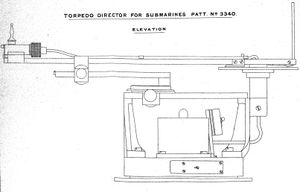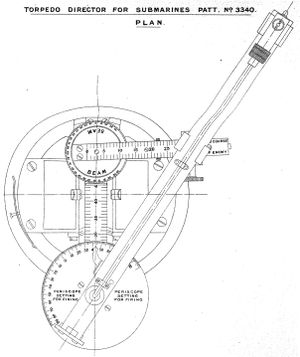Torpedo Director Pattern 3340: Difference between revisions
(Redirected page to Torpedo Director#Pattern 2236) |
No edit summary |
||
| Line 1: | Line 1: | ||
[[File:HandbookTorpedoControl1916Plate6.jpg|thumb|300px|Pattern 3340 Elevation View<ref>''Handbook of Torpedo Control, 1916'', Plate 6.</ref>]] | |||
[[File:HandbookTorpedoControl1916Plate5.jpg|thumb|300px|Pattern 3340 Plan View<ref>''Handbook of Torpedo Control, 1916'', Plate 5.</ref>]] | |||
The '''Torpedo Director Pattern 3340''' was a [[Torpedo Director|torpedo director]] created for use in submarines. It was probably introduced in 1915.<ref>Inference based on its description in ''Annual Report of the Torpedo School, 1915'', p. 59.</ref> | |||
==Design== | |||
The basic design was similar to other Royal Navy directors: a torpedo bar and an enemy bar. When the submarine attacked a target on the surface, the 3340 would be shipped to the periscope head in any of four positions so that its torpedo bar would be aligned with the angle of the tube being fired whether ahead, astern, or on either broadside.<ref>''Annual Report of the Torpedo School, 1915'', p. 59.</ref> | |||
A pair of discs were fitted to see the director angle by which the periscope could be set for submerged firing, and the other disc indicating the crossing angle between enemy heading and torpedo bar.<ref>''Handbook of Torpedo Control, 1916'', p. 18.</ref> The second disc, essentially a [[Longmore Disc]], reflected the submariners' preference for measuring inclination relative to the torpedo tube rather than to line of bearing, as at the short ranges customary to submarine attack created high bearing rates and thus inclination to line of bearing changed more rapidly than inclination to line of torpedo firing.<ref>''Annual Report of the Torpedo School, 1915'', p. 59.</ref> | |||
==Alterations== | |||
==See Also== | |||
==Footnotes== | |||
{{reflist}} | |||
==Bibliography== | |||
{{refbegin}} | |||
{{refend}} | |||
{{TorpedoDirector}} | |||
Revision as of 16:16, 1 April 2011


The Torpedo Director Pattern 3340 was a torpedo director created for use in submarines. It was probably introduced in 1915.[3]
Design
The basic design was similar to other Royal Navy directors: a torpedo bar and an enemy bar. When the submarine attacked a target on the surface, the 3340 would be shipped to the periscope head in any of four positions so that its torpedo bar would be aligned with the angle of the tube being fired whether ahead, astern, or on either broadside.[4]
A pair of discs were fitted to see the director angle by which the periscope could be set for submerged firing, and the other disc indicating the crossing angle between enemy heading and torpedo bar.[5] The second disc, essentially a Longmore Disc, reflected the submariners' preference for measuring inclination relative to the torpedo tube rather than to line of bearing, as at the short ranges customary to submarine attack created high bearing rates and thus inclination to line of bearing changed more rapidly than inclination to line of torpedo firing.[6]
Alterations
See Also
Footnotes
- ↑ Handbook of Torpedo Control, 1916, Plate 6.
- ↑ Handbook of Torpedo Control, 1916, Plate 5.
- ↑ Inference based on its description in Annual Report of the Torpedo School, 1915, p. 59.
- ↑ Annual Report of the Torpedo School, 1915, p. 59.
- ↑ Handbook of Torpedo Control, 1916, p. 18.
- ↑ Annual Report of the Torpedo School, 1915, p. 59.
Bibliography